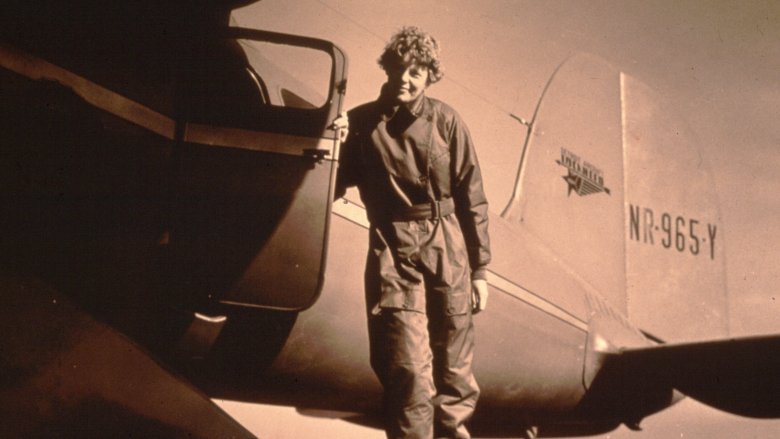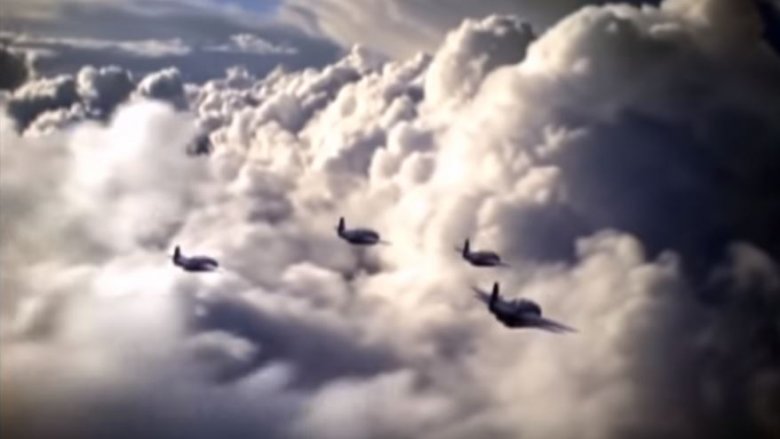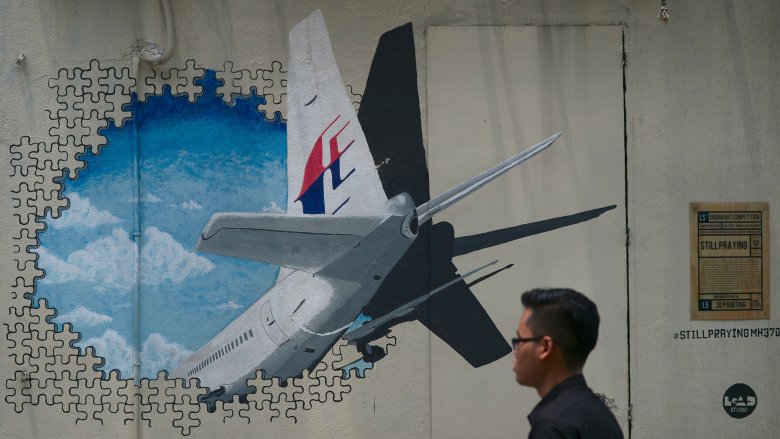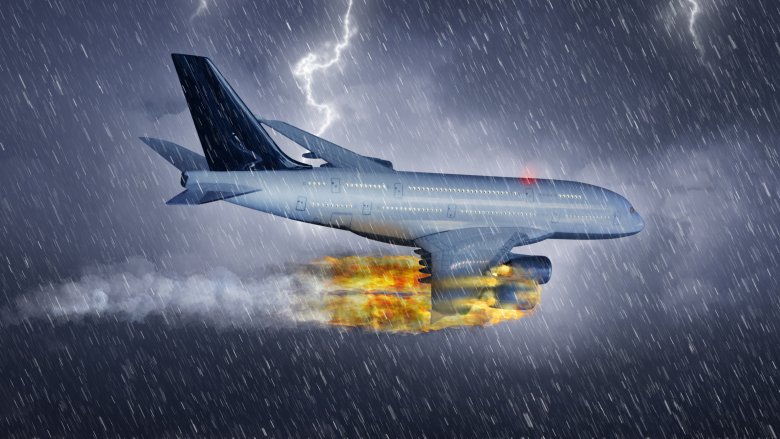Airplanes That Mysteriously Vanished
There's nothing like getting on a plane for the first time. Sure, by the time you're a flying veteran, it's easy. That maiden trip, though? Just remember the rattling, the forward thrust, the surreal smallness of everything beneath you, and the sudden rush of air as the plane soars into the clouds ... and now imagine if your plane never came out of those clouds. Sadly, this exact scenario has happened more often than you think, and not just in TV shows like Lost.
It's one thing when a plane crashes, leaving wreckage, bodies, and evidence, but a disturbingly large number of flights have simply vanished into the fog, leaving the world grappling for answers. Sometimes, the truth came out years later. Other lost planes remain a mystery. No matter what, any giant hunk of metal that fades into the clouds leaves a lot of questions, investigations, and conspiracy theories in its wake.
Airplane-UFO creepiness
What happens when a flying saucer fan vanishes in thin air? Well, you can imagine the stories that get told.
This exact scenario happened in 1978, when the Associated Press reported that 20-year-old Frederick Valentich, a devoted student of UFOs, had disappeared near Australia during a 125-mile test flight with no trace, no body, and no signs of a crash. Eerier still was Valentich's final recording, spoken live to air traffic control, where he claimed that a long, metallic ship — emitting an ethereal green light — was looming over him, playing some sort of game. His final words, as transcribed by the Skeptical Inquirer, were "It is hovering, and it is not an aircraft." Creepy.
Valentich's plane vanished off the coast of the Bass Strait, and once news broke, almost a dozen people reported UFO sightings in the area because of course they did. Many have speculated that Valentich disappeared intentionally, but the Australian Broadcasting Corporation writes that he did not exhibit outward signs of depression or suicidal behavior. On the other hand, given Valentich's inexperience as a pilot, he may just have experienced an entirely normal phenomenon and simply interpreted it as a UFO. Unfortunately, we'll probably never truly know happened to this young man, unless a flying saucer touches down on a mountaintop in 20 years, a la Close Encounters of the Third Kind, and an un-aged Valentich walks out.
The most discussed airplane disappearance in history
Perhaps the most famous pilot of all time was Amelia Earhart, the pioneering aviatrix who broke records for air travel, broke boundaries for women, and broke the rules of her time. Even when she wasn't up in a plane, Earhart helped craft a better future on the ground, whether through her early work as a nurse's aid and social worker or her unwavering support for the Equal Rights Amendment.
As everyone knows today, though, Earhart's story ended tragically. On July 2, 1937, while Earhart and her navigator Fred Noonan were embarking on an epic flight circling the entire globe, they disappeared somewhere in the Pacific. Time magazine writes that it took almost two years for her to be declared legally dead, after a painful search and rescue mission proved futile. No answers were ever found, but most likely — anti-climactic as it may be — her plane simply ran out of gas, drowning her and Noonan under the waves. Nonetheless, the last century has been full of bizarre theories about Amelia Earhart's disappearance, ranging from the odd (she was a spy) to the outright bizarre (she was eaten by giant crabs).
The Bermuda Triangle welcomes all airplanes
You can't go to a party and say the phrase "missing airplanes" without somebody bringing up that ol' vortex of doom known as the Bermuda Triangle. In reality, the legends are blown out of proportion, but the infamous disappearance of Flight 19 was admittedly quite bizarre.
Here are the facts, according to History. On December 5, 1945, a group of experienced Marine and Navy pilots took off from Florida in five TBM Avenger torpedo bombers. These planes, collectively called Flight 19, behaved normally ... until suddenly, the flight leader started making wacko decisions, due to his belief that the compass had malfunctioned. After a few too many wrong turns, with the leader at one point claiming he had deviated hundreds of miles off course, Flight 19 got lost in heavy fog, winds, and rain. Finally, the planes drifted out over the ocean, and all communications halted with a scary buzzing sound.
Just like that, Flight 19 was gone. Weird? Sure, but here's the weirder part. The Navy immediately mounted a search and rescue mission, sending two PBM Mariner flying boats to find the missing airmen. In a horrifying twist, one of those Mariners went off the radar in less than 20 minutes, taking 13 men with it. Believe what you will, but to this day, the remains of Flight 19 and the Mariner have never been found.
The all-time most expensive search in aviation history
In the 21st century, thankfully, missing airplanes aren't as common as they used to be. That's why the world reeled in 2014, according to CNN, when the passenger plane Malaysia Airlines Flight 370 took off from Kuala Lumpur, headed toward Beijing, and disappeared, taking 239 lives with it. For four years, the combined forces of China, Australia, and Malaysia combed the Indian Ocean for answers, funneling millions of dollars into the costliest missing aircraft search in history. Sadly, only a few scraps were found, some of which had washed up in eastern Africa, an improbably far distance from the area where the plane probably crashed.
In lieu of proven facts, observers have advanced numerous theories regarding the MH370 catastrophe. Some believe the pilot intentionally crashed the plane. Others, according to the Week, have weighed the notion that the entire cabin may have instantly depressurized, killing everyone on board — except the confused copilot, who might have flown this "ghost plane" for hours before it wrecked, with the depressurization explaining his strange route. There's also the chilling possibility that the flight was shot down, which has happened to other passenger flights. On the other hand, the plane could have simply run out of fuel and crashed into the water.
Stealing a really big airplane
If the mystery of this lost 727 were turned into a movie, it would begin at sunset. "May 25, 2003: Luanda, Angola" would unroll across the bottom of the screen, and the shadowy outline of flight engineer Ben Charles Padilla would rise from the bottom, accompanied by his helper John Mikel Mutantu. The two men would mysteriously board a Boeing 727, tail number 844AA, and then — without clearance — taxi erratically down the runaway and take off over the Pacific Ocean. The plane would disappear into the clouds, never to return, and the rest of the film would depict Homeland Security, the CIA, the FBI, and Ben's sister, Benita Padilla-Kirkland, desperately hunting for answers.
Of course, this happened in real life, and according to Air & Space Magazine, to this day no one knows why 844AA was stolen.
Before the theft, Padilla and Mutantu had been fixing up the plane, but neither men had the skills or experience to fly it. The bizarreness of it all and the fact that it happened just a few years after 9/11 sent U.S. intelligence scrambling for answers, terrified it might be another terrorist attack. What did they find? If they found anything, they haven't revealed details, but Padilla's sister said in 2010 that she hoped Ben might still be hiding away somewhere.
Desperate survival after an airplane crash
Many stories of airplanes disappearing end with no answers. The mystery of Uruguayan Air Force Flight 571, though, was answered in the most gruesome, tragic manner possible. According to Britannica, this flight — also called Miracle of the Andes — had been chartered by a Uruguayan rugby team in 1972, but it went off the radar during a pass through Argentina's Andes Mountains. Today, it has been revealed that the plane smashed into these snowy peaks, losing both wings and crashing into a remote valley. Back then, though, the plane had simply vanished. After eight days of fruitless searching, the rescue operations were called off.
Months later, despite the odds, a desperate crew of survivors was found, but their story was anything but pleasant. After the initial crash killed 12, the 33 remaining passengers had struggled to endure the harsh, freezing conditions. When the meager food supplies from the plane ran out, starvation forced them to eat the corpses of their fellow passengers. By the time they were finally able to contact society and get rescued, only 16 of these survivors remained, and the revelation that they had resorted to cannibalism — even considering the desperate conditions — resulted in a significant backlash. Since then, a number of Flight 571 survivors have published memoirs about their horrifying experiences.
The Devil's Triangle strikes again
The disappearance of Flight 19 was the match that ignited all those roaring Bermuda Triangle theories you know today. However, the three-pointed flames were fanned by the equally bizarre 1948 vanishing of the Star Tiger, according to Forbes. The fearsomely named aircraft was an Avro York Tudor IV going from London to Havana, and it vanished without a trace only 340 nautical miles from Bermuda, taking the lives of 26 passengers and six crewmen. What happened? Bermuda Triangle black magic aside, it's been hypothesized that the Star Tiger was flying at low altitudes to avoid strong winds. This maneuver would have burned fuel at an accelerated rate, and didn't give much room to avoid danger if any problems came up. See, there's usually a logical explanation.
This being the Bermuda Triangle, though, another Tudor IV plane vanished in the same location the very next year, according to HowStuffWorks. This aircraft, the Star Ariel, was en route to Jamaica when it blinked out of existence. No debris was ever found. After the losses of the Star Tiger and Star Ariel, British South American Airways decided to quit building Tudor IV planes.
Was this airplane taken down by sabotage?
On March 14, 1962, the Milwaukee Sentinel reported that a charter airline carrying 96 military passengers and 11 crewmen, Flying Tiger Flight 739, had gone missing in action, somewhere over the Pacific.
According to Fear of Landing, the plane had undergone routine maintenance beforehand, with no issues found, before departing from Guam. During the flight, all reports were normal, until the plane disappeared. Because of this, the plane's loss was a total mystery, and it ignited a desperate search — at the time, one of the most exhaustive in history — which never turned up any wreckage, bodies, or other signs of what happened. Perhaps the only clue is a report from a nearby tanker, where men claimed to have seen an explosion in the sky, following by two flaming objects toppling downward, as if an airplane had been ripped in two. However, no debris was found in this location. Today, there are people who believe the flight may have been sabotaged, but there is no proof.
An airplane disappearance that spawned all the conspiracy theories
On August 2, 1947, the BSAA Avro Lancastrian Star Dust went missing in the Andes Mountains, according to Vintage News. Nothing was found. No wreckage. No bodies. You know the drill. However, for the next half-century, rumors and mythology spilled from the story like a grab bag of conspiracy theories.
Part of this probably had to do with the flight's crew being former World War II bomber pilots, combined with the veritable who's who of interesting passengers, including a British diplomat, a German woman allegedly carrying the ashes of her dead husband, and a Palestinian businessman with a diamond stitched into his coat. Sounds like a game of Clue, right? Some of the legends swirling around this flight were that it may have been hijacked by Nazis, abducted by aliens, or that a passenger had been smuggling stolen gold. To make things even more mysterious, the flight's final transmission — given in Morse code — was the word "STENDEC." What does it mean? Nobody knows, but it's been hypothesized to either be an anagram for "DESCENT," or a World War II acronym meaning "Severe Turbulence Encountered, Now Descending, Emergency Crash-landing."
In the end, none of the crazy theories were true. In 2000, the Guardian reported that Argentinian soldiers had finally uncovered wreckage and frozen human remains from the flight. Further investigations proved that the plane crash was caused not by Nazis, gold, or aliens but the mundane tragedy of bad weather.
What happened to Glenn Miller and his airplane?
Though youngsters might not recognize him today, the musician Glenn Miller was a big deal in the '30s and '40s. Between millions of records, a slew of top ten hits, and an orchestra that earned rave reviews, much of the world knew Miller's name, so he got a lot of attention when he left behind his blockbuster career to fight in the U.S. Army during World War II. It was in this capacity that Miller's life tragically ended on December 15, 1944, according to Colorado Public Radio, when he boarded a UC-64A Norseman in England, went in the direction of France, and was never heard from again.
How did the plane go down? For decades, the cause of Miller's vanishing was a complete mystery, but recent research into public military documents has pointed toward the possibility that since his plane was flying low — due to visibility issues — the fuel lines might have frozen. This would've given the pilot only eight seconds to save the plane from crashing into the water. Though some believed the plane may have disintegrated upon impact, an English fisherman announced in 2019 that he thought he found the aircraft's remains all the way back in 1987 but simply left the wreckage in place on the orders of the Coast Guard.
From lost flight to tragic phrase
The Chilean phrase "more lost than Lieutenant Bello" refers to a real person, and as you can probably guess, his story did not end well.
According to Historic Wings, Alejandro Bello Silva was one of Chile's first military pilots, and on the fateful day of March 9, 1914, he took off on the last flight he needed to complete in order to earn his military aviator wings. It should have been a victorious day, and while the 111-mile cross-country trip before him would've been difficult for any pilot of his time, he was more than up for the challenge. Unfortunately, a thick fog came up, and once he disappeared inside it, he was never heard from again. In the century since, many have hypothesized that he may have either dropped into the ocean or crashed into the mountains, but no wreckage has ever been discovered. To this day, Lieutenant Bello's remains are just really, really lost. He will most likely never be found.
The very first airplane disappearance
Everything has to start somewhere. For almost as long as humans have successfully pretended to be really fat birds, our really big bird costumes have gone missing. The first airplane to ever be reported missing was a Short S.27 biplane piloted by Cecil Grace in 1910, according to Plane & Pilot Magazine.
At the time, Historic Wings writes that Grace had been competing in the Baron de Forest Prize competition, which was an award of £4,000 given to whichever pilot could leave England, go over the English Channel, and make it the farthest into continental Europe. Now, keep in mind, aviation was pretty new at this time, so an expedition like this was really a crapshoot. Nonetheless, Grace and other early pilots were lured in by the thrill of adventure and the hefty cash prize. Grace embarked on his daring journey, headed straight into the fog of the English Channel, and was never seen again. Whether he got lost due to poor visibility, suffered an engine failure, or ran out of fuel is a mystery that may never be solved, but regardless, it's likely that his remains are still buried somewhere deep within the English Channel.












